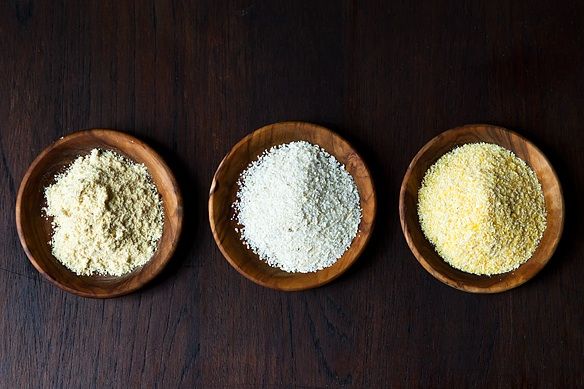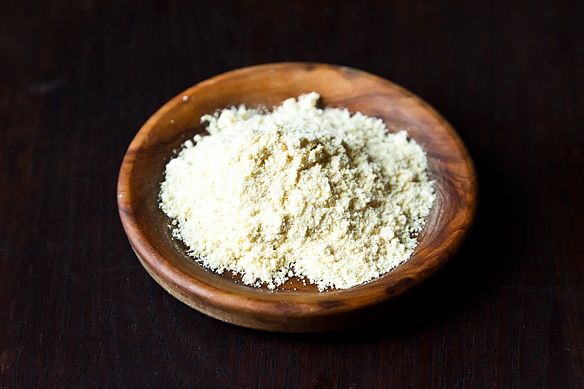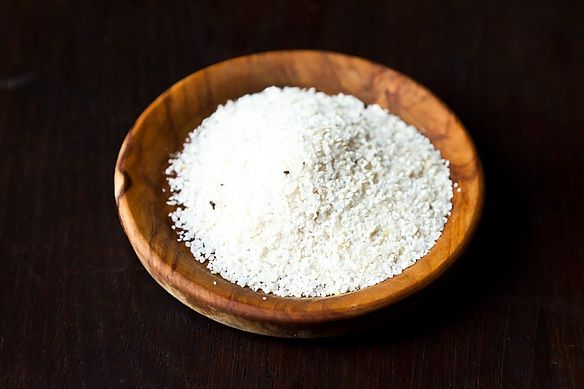Popular on Food52
Continue After Advertisement
42 Comments
lemema
June 17, 2023
So, where does masarepa fit in? (Precooked masa that is NOT nixtamalized. I believe).
Kathy957
April 11, 2022
So if I underbake my cornbread and the inside is still runny, have I created some kind of fancy breaded polenta dish?
Becky W.
December 16, 2018
I’m not much a cook. I used to get tamales that were said to be made from grits (for the outside). Wonderful taste. Any suggestions as to how to make?
Tara M.
June 13, 2018
Masa just means dough. Harina means flour. So tortillas made from having are usually made with Maseca flour and water. While tortillas de maîz and made from boiled dried corn with lime, then ground. At least in El Salvador. White corn. The word harina can be any type of flour, like flour for bread or cakes, for example.
ND731
November 16, 2017
I don't get it. Why do you think grits and cornmeal are the same thing? Grits are ground hominy - which is corn that has been treated with lye. Two completely different products. Similar. But not the same thing at all.
J R.
January 14, 2024
Yes. Another confusion in this is article is that masa harina is not ground hominy. Masa harina is made from posole (nixtamalized flint corn) is a cousin of hominy (nixtamalized dent corn) but they are not the same even though again there is no industry standard that is in common use. The different corns have a subtle but unmistakable impact. Hominy is primarily made from dent corn and posole is made from flint corn and best when a heirloom corn is used. Posole has a stronger tooth than hominy and a distinctly rich flavor. Hominy and grits are wonderful. Posole and masa harina are their own things. Southerners do not make grits from posole and folks in Mexico and the Southwest US do not make tortillas, tamales, or posole (the stew) from hominy. While each can stand in for the other in a pinch, why bother when both are so readily available these days.
Perry
November 22, 2016
So what I gather whether polenta, cornmeal, corn grits or masa, corn is corn, and it comes down to the grind, outside of addition processing like par-cooking and calcium hydroxide treatment. You all helped provide the clarity I was looking for. Thank you
Sally
May 26, 2016
I just made corn muffins out of corn grits, and they turned out perfect, also made polenta too, for dinner later with vegtables. Glad I found this site.
Esther
January 3, 2016
So it's okay to use cornmeal to make cheese grits? I ask because I'm from the Philipines and all cornmeal, grits, polenta etc are imported. I buy Bob's Red Mill. I want to make Cheesy Shrimp Grits for a special breakfast but what I have on hand is medium grind cornmeal. I hope someone can help me. Thanks!
amanda R.
May 5, 2018
This is a super late answer, but yes, you can use cornmeal to make cheese grits!
Lola P.
May 23, 2015
I think i am the only one in the world who does this, but i like to pour about half oil, hallf yellow cornmeal, and salt in a pot, stir, heat ut till blended. Then ate with a plastic spoon for two weeks. It my fav snack
Barbara
March 27, 2015
My all-time favorite thing to make with cornmeal is cornmeal mush. You cook it in a bit of water like you would Cream of Wheat, and let it become very thick, then pour it into a butter-greased loaf pan and refrigerate it. When it is solid or the next day, cut 1/4" inch thick slices, dredge them in flour, and fry them in a skillet until they are slightly golden and crisp. I prefer them with just plenty of cold butter slathered on while they're hot, but others like them with maple syrup. I also make large batches of my own cornbread mix then package it as individual kits for a single meal.
beejay45
December 28, 2014
I make polenta casseroles, often using up leftovers. I once brought one of these casseroles to a party where a Southern friend dubbed them "fancy grits," so you can see the overlap. ;)
For example, I have some cheese-laden crab and spinach dip leftover. I'll either stir that into a pot of cornmeal for a really rich bowl of "grits," or make myself an au gratin dish of polenta topped with it -- that and a salad will make me a great lunch. At our house, though, the number one favorite polenta is pepperoni pizza -- about two inches deep of cheese polenta topped with tomato sauce, grated Mozz, pepperoni and olives, then baked until the cheese melts and it's all bubbly and delicious.
For example, I have some cheese-laden crab and spinach dip leftover. I'll either stir that into a pot of cornmeal for a really rich bowl of "grits," or make myself an au gratin dish of polenta topped with it -- that and a salad will make me a great lunch. At our house, though, the number one favorite polenta is pepperoni pizza -- about two inches deep of cheese polenta topped with tomato sauce, grated Mozz, pepperoni and olives, then baked until the cheese melts and it's all bubbly and delicious.
beejay45
December 28, 2014
I make polenta casseroles, often using up leftovers. I once brought one of these casseroles to a party where a Southern friend dubbed them "fancy grits," so you can see the overlap. ;)
For example, I have some cheese-laden crab and spinach dip leftover. I'll either stir that into a pot of cornmeal for a really rich bowl of "grits," or make myself an au gratin dish of polenta topped with it -- that and a salad will make me a great lunch. At our house, though, the number one favorite polenta is pepperoni pizza -- about two inches deep of cheese polenta topped with tomato sauce, grated Mozz, pepperoni and olives, then baked until the cheese melts and it's all bubbly and delicious.
For example, I have some cheese-laden crab and spinach dip leftover. I'll either stir that into a pot of cornmeal for a really rich bowl of "grits," or make myself an au gratin dish of polenta topped with it -- that and a salad will make me a great lunch. At our house, though, the number one favorite polenta is pepperoni pizza -- about two inches deep of cheese polenta topped with tomato sauce, grated Mozz, pepperoni and olives, then baked until the cheese melts and it's all bubbly and delicious.
April J.
November 3, 2014
Masa is the Spanish word for dough, Masa Harina is the flour that is used to make Masa for making corn tortillas and tamale dough. Hominy is known in Spanish as Maiz Pozolero and is what you are describing as being treated. It is also available in cans, both small and large, usually used for making Pozole (Pork and Hominy Stew).
mariakarmina
March 25, 2023
hi April J....I know I am late here considering it has been 8yrs since you wrote that info above, but worth a try anyway! I am hoping that since you knew that Maize Pozolero was hominy....can you tell me possibly what would just polenta or cornmeal be called in Mexico? Because what they have here is harina de maize, and it is the flour made by grinding the cornmeal even finer than we in the USA use.....and I can not find regular cornmeal or polenta here in Mexico anywhere. So, I am supposing you don't have any more clue than me, and at that point, I will either need to get my own grinder or find a molinero? A person who grinds the corn for use as a meal or grits or polenta, or like here, the harina de masa....and I could explain to them maybe not to grind my corn so fine! If you have time to answer, I would love to hear back from you....and if not, Thanks anyway! have a great day!
les C.
March 25, 2023
It`s never to late to help someone,I would suggest ordering on Amazon so you don`t drive yourself crazy.Mexico City has a Whole Foods,they will have Polenta.Finding a molinero is a excellent idea,maybe at the supermarcado or farmers market.Good Luck!
April J.
March 26, 2023
I am always happy to help if I can. From what I have seen, there is not a specific name to differentiate polenta and cornmeal from the finer harina de maiz that is used for torillas. You just need to look for the descriptor that specifies the coarseness of the grind. So "harina de maiz amarilla gruesa" such as that packaged by Goya, would be roughly equivalent to a polenta or coarse cornmeal. Depending on where you are located in Mexico, it maybe easier to find a molinero and request that they give you a coarse grind. Though if you have an Aurrera store nearby, you will likely be able to get something prepackaged there.
susan G.
November 20, 2013
I recently 'toured' Kenyon Grist Mill in Rhode Island, at their annual Johnnycake Festival. Aside from eating wonderful jonnycakes, seeing the mill in operation was a treat! It's exactly as it was over 200 years ago -- with electricity added. There is presently only one wheel in use, and we watched as the corn was added, ground by the old stones, and delivered into a barrel on the floor below; heard about the maintenance of the stones; and more. Take a look at their website.
susan G.
November 20, 2013
You make cornbread with cornmeal, sometimes other flours also. Look at the upper right of the screen, where it says Search... Put in 'cornbread' and set it to 'Recipes' if it isn't already, then click on the magnifying glass icon on the right. You'll find many wonderful recipes there.
lifeandlarder
November 20, 2013
Susan G, you missed the joke - they are all 'cornmeal'!
'Cornmeal' as such, isn't on the shelves in Australia. I made some cornbread recently, and used 1/3 wheat flour, and 2/3 polenta with some added baking powder, sour cream, tasty cheese, and chopped jalapeños! Tasted great (even if not authentic) served with fried chicken and coleslaw!
'Cornmeal' as such, isn't on the shelves in Australia. I made some cornbread recently, and used 1/3 wheat flour, and 2/3 polenta with some added baking powder, sour cream, tasty cheese, and chopped jalapeños! Tasted great (even if not authentic) served with fried chicken and coleslaw!
susan G.
November 20, 2013
Sounds perfect -- a little more bite. You could post the recipe and teach us something.
mariakarmina
March 25, 2023
You are so correct! Except here in Mexico, they are all corn flour!! They don't have corn meal here either, but neither do they have polenta, so I am probably going to have to get my own grinder and make my own cornmeal!
lifeandlarder
November 20, 2013
So what do you make cornbread with? Thats all I wanted to know? ;(
mariakarmina
March 25, 2023
corn bread is made with corn meal. Some countries, such as Mexico, don't seem to know what corn meal is. It looks like in the UK they may not have corn meal either, but if you don't have corn meal, you can always purchase the dried corn here in Mexico and grind it yourself!
Chris F.
September 13, 2013
Cornflour (one word) as used in Australia, New Zealand, and maybe England is the same as cornstarch in the U.S. Cornmeal (two words?) as sold in the South of the U.S. is a mixture of ground corn, self rising/raising flour and salt, facilitating the making of cornbread.
Frank W.
August 22, 2013
I believe the best polenta is milled from northern flint corns such as Roy's Calais from Vermont. Coarsely milled, then screened, the large hard chunks of the higher protein flint corn make for a wonderful creamy textured polenta. The finer screenings are fine for mush, baking or added to griddlecakes/waffles.





See what other Food52 readers are saying.